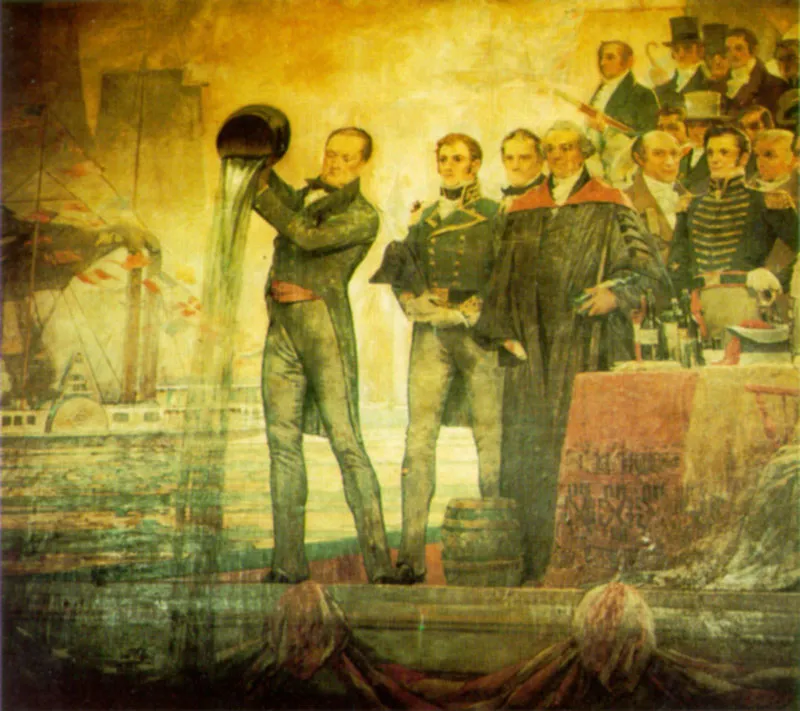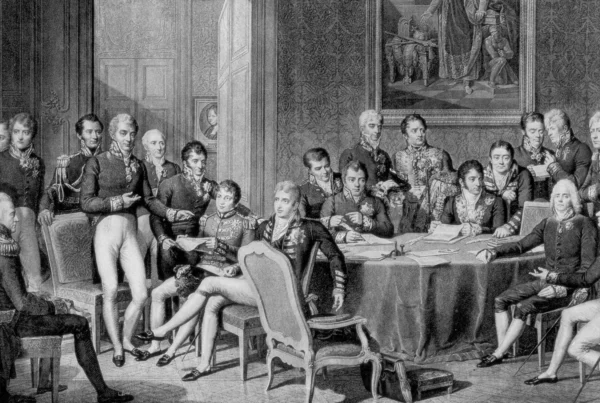2025 marks the 200th anniversary of the completion of the Erie Canal in New York state, the first navigable waterway connecting the Atlantic Ocean to the Great Lakes. Dubbed “The Nation’s first superhighway” it revolutionized American trade and expansion. In a series of Christmas Day 2024 social media posts on his Truth Social Platform, President-elect Donald Trump suggested the United States take control of the Panama Canal. What can the history of the Erie Canal tell us about Trump’s vision for the Panama Canal?
David Deegan
15 January 2025
Arabic version | French version | German version | Spanish version
Construction of the 360-mile waterway crossing upstate New York to connect the Hudson River to Lake Erie began in 1817, and was championed by New York Governor, DeWitt Clinton. Despite heavy criticism from his political opponents, the toll revenue recovered the state’s construction debt within the first year of operation and transformed New York into the nation’s economic powerhouse. By drastically reducing transportation costs of both people and goods across the Appalachian Mountains and opening the Midwest to global markets, the Canal cemented the United States’ role as a trade leader, strengthening US sovereignty and economic independence.
Trump’s rhetoric regarding the Panama Canal echoes this earlier vision on the Erie Canal. The Panama Canal was handed over to Panama in 1999, and Trump has suggested that its return to U.S. control could restore American dominance over critical trade routes. As with the Erie Canal in the 19th century, the Panama Canal could be seen as a tool to bolster economic nationalism and ensure the United States remains at the center of global commerce.
In the same way that the Erie Canal linked inland agricultural producers to international markets, enabling the US to dominate domestic and foreign trade, the Panama Canal is a critical artery for global commerce in the 21st century, facilitating the movement of goods between the Atlantic and Pacific Oceans. According to the trade publication CargoNOW, about 40% of U.S. container shipping currently travels through the Panama Canal.
 “The Marriage of the Waters” by C.Y. Turner, 1905. A mural decoration in the DeWitt Clinton High School, N.Y.C. depicting Governor DeWitt Clinton pouring water from Lake Erie into the ocean at New York in a ceremony celebrating the “Marriage of the Waters” between Lake Erie and the Atlantic in 1825. (From the Erie Canal Historical Images site)
“The Marriage of the Waters” by C.Y. Turner, 1905. A mural decoration in the DeWitt Clinton High School, N.Y.C. depicting Governor DeWitt Clinton pouring water from Lake Erie into the ocean at New York in a ceremony celebrating the “Marriage of the Waters” between Lake Erie and the Atlantic in 1825. (From the Erie Canal Historical Images site)
The Erie Canal epitomized American ambition. Its construction overcame significant natural barriers, including dense forests, rocky terrain, and logistical challenges. Similarly, the Panama Canal, completed in 1914, represented an engineering feat that showcased US ingenuity, capabilities and global leadership. Both projects demonstrated how transformative infrastructure could symbolize a nation’s rise to power.
Trump’s “America First” agenda similarly emphasizes infrastructure as a means to reclaim and retain national greatness. Regaining control of the Panama Canal aligns with this vision, portraying the canal as a strategic and symbolic asset that reflects American power and serving as a tangible reminder of the nation’s capacity for bold and visionary projects.
The Erie Canal’s success was rooted in its ability to maintain US economic autonomy. By keeping trade routes within American borders, it ensured that profits and influence remained in domestic hands.
Today, the Panama Canal presents a starkly different reality. Although the US constructed and operated the canal for much of the 20th century, its transfer to Panama has led to debates over foreign control and influence, particularly by China.
A subsidiary of Hong Kong-based CK Hutchison Holdings manages two ports at the canal’s entrances, with Chinese firms contributing over USD 1 billion towards construction of a new bridge over the canal, activities which are distinct from the canal’s governance and operations. However, these investments in ports and infrastructure and the growing influence of China in Latin America has heightened US concerns about losing strategic control over this vital trade route, culminating in Trump’s Christmas Day proposals.
Shortly after Trump’s December 2024 statements and allegations, Panama’s President Jose Raul Mulino refuted them at a press conference, stating “There is absolutely no Chinese interference nor involvement in anything to do with the Panama Canal”. The Panama Canal Authority, an autonomous government agency, has maintained full control since December 1999, following the 1977 Torrijos-Carter Treaties which guaranteed the canal’s neutrality and access for global shipping.
 Map showing the route of the Erie Canal from Waterford on the Hudson River to Lake Erie. (From the Minnesota Libraries Publishing Project)
Map showing the route of the Erie Canal from Waterford on the Hudson River to Lake Erie. (From the Minnesota Libraries Publishing Project)
Mid-America Freight Coalition estimates the Canal supplies 12% of Panama’s gross domestic product. Normally container ship transits cost somewhere between USD 60 000 and 300 000, but waiting times for access mean that companies will pay extra to “jump the queue”. During a drought in 2023 which caused wait times to soar, Japan’s Eneos Group paid almost USD 4 million for one ship to pass through.
Just as the Erie Canal shaped and supported US economic expansion, Trump views the Panama Canal as essential for countering foreign influence and maintaining US geopolitical dominance. Regaining control of the Panama Canal could counterbalance this actual and perceived foreign influence, reinforcing American dominance in the region and reducing reliance on foreign powers for critical trade infrastructure.
In 1809, President Thomas Jefferson called the prospect of building a canal through the state of New York “little short of madness.” DeWitt Clinton’s political opponents, a Republican faction known as the Bucktails, derisively described the project as “Clinton’s Folly” and pressed for his removal from the commission. They did not succeed. Instead, the Erie Canal’s completion marked a turning point in the nation’s ascent to global prominence and was followed by Clinton’s re-election as New York Governor in 1826.
Similarly, Trump’s interest in the Panama Canal could be viewed as part of a broader effort to cement his legacy. By attempting to regain control of the canal, Trump could frame himself as a defender of American sovereignty and trade dominance, aligning with his broader narrative of restoring US greatness.
Both canals, though separated by nearly a century, highlight the enduring importance of infrastructure in shaping a nation’s development and affecting the political success of individuals involved. However, despite its historical significance, the Erie Canal eventually faced obsolescence with the rise of railroads and is now predominantly a tourist attraction.
Similarly, the importance and role of the Panama Canal is currently challenged by modern developments, including competition from alternative trade routes such s the Arctic shipping lanes and China’s Belt and Road Initiative.
A country’s infrastructure shapes economic growth, geopolitical influence, and political legacies and is therefore a cornerstone of national policy and strategy.
Both the Panama and Erie canals symbolize bold visions of American power. However, they also highlight the challenges of maintaining dominance in an ever-changing world. They therefore present complexities and possible problems for Trump’s vision/aim to regain control of the Panama Canal.







